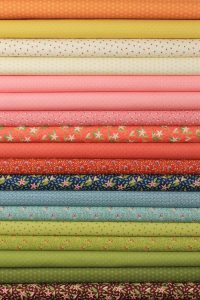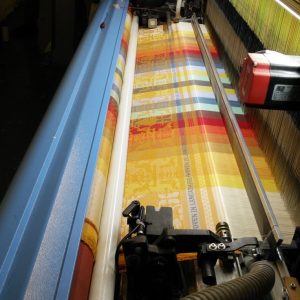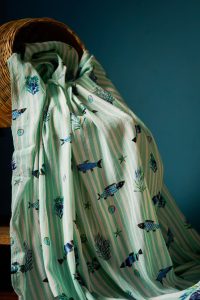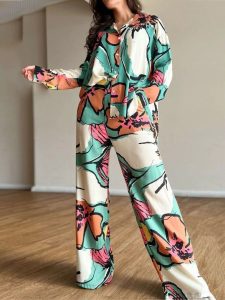Market Forecasts and Trends in the Fabric Printing Industry from 2022 to 2030
Global reports and studies show that the “digital fabric printing” market is rapidly growing. The global value of fabric printing was estimated at 2.2 billion USD in 2019, and it is expected to reach 8.8 billion USD by 2027, with a 19% growth rate. Additionally, the global fabric market value was 146.6 billion USD in 2018, and it is expected to grow by 8.9% by 2025.
The global digital fabric printing market was estimated at 2.46 billion USD in 2021, and it is forecasted to grow at a compound annual growth rate (CAGR) of 12.1% until 2030. The rapid pace of fashion changes and the demand for covering various tastes are among the key factors driving the growth and popularity of digital fabric printing.
Digital printing technology can be used for a variety of applications, from banner and flag printing to curtains, bedspreads, etc. However, as digital printing equipment is equipped with highly advanced technologies, the global market currently faces a shortage of skilled operators in this field. The fast-paced changes in fashion and the need to cater to various tastes are among the most significant factors contributing to the growth and popularity of digital fabric printing.
Digital printing developers are investing heavily in the research and development (R&D) sector to gain a competitive advantage and increase market share. For instance, Seiko Epson has finalized the purchase agreement of For.Tex Srl, a company that distributes digital printing supplies such as inks, adhesives, toners, and more, and operates as an R&D unit. Although digital printing is still in its early stages compared to traditional printing technologies, many fabric and garment manufacturers have already turned to digital printing technologies. The shift from traditional to digital printing in the fabric printing sector began in Europe and is now expanding to other regions of the world.
The increasing demand for fabric printing has caused the industry to continue its upward trajectory in a sustainable manner. Currently, digital printing holds less than ten percent of the total fabric printing market share, but with the ongoing technological advancements, it is expected that digital printing will capture at least a quarter of the market share in the next decade. One of the key factors in the growth of digital printing is the increase in the income of the middle class and the rising trends and changes in fashion and style across various societies.
Another emerging digital printing market contributing to its growth is the market for automotive covers and interior decoration printing. Although other hindering factors, such as the high costs of digital printing materials and components like inks and printheads, prevent the sudden expansion of digital printing in this market, it can still be predicted that with further development and progress in the coming years, many of these challenges will be overcome.
Digital printing technologies not only increase workflow speed but also enhance work efficiency. As a result, manufacturers can deliver customer orders more quickly and increase their production capacity. Large apparel manufacturers are fully utilizing these advantages of digital printing.
Leading Technologies in Digital Printing
In 2021, the most common digital fabric printing method was the Direct to Fabric (DTF) printing method, which accounted for 67% of the digital printing market. In this method, patterns and images are directly printed onto fabric rolls, and after the printing process is complete, the fabric is cut and used for various applications. In DTF printing, various types of inks can be used, including pigment inks, reactive toners, dye sublimation inks, and acid toners.
Another common method in digital fabric printing is Direct to Garment (DTG) printing, which is used for direct printing on t-shirts, school uniforms, fabric used in sports clubs, and other non-roll fabrics. DTG printing currently has the fastest growth rate in the digital fabric printing industry.
Primary Fabrics for Digital Fabric Printing
Currently, cotton fabrics, with a 52% share, are the most common fabric used for digital printing. Cotton fabrics are in high demand in both fashion and sportswear industries due to their high durability and excellent moisture absorption properties. In the interior decoration market, cotton fabrics are also the top choice for printing items like bedspreads, curtains, tablecloths, etc.
After cotton fabrics, polyester fabrics are the most popular among fabric printing customers. Polyester fabrics, with an annual growth rate of 12.9%, are the most demanded fabrics for digital printing. Due to their high resistance to wear and wrinkles, combined with the low cost of the fabric, polyester has quickly made its way into the apparel industry. Sublimation ink is the most common ink used for printing on polyester fabrics. Silk fabrics are also the third most popular in digital printing, especially in Japan and the Gulf countries. However, the high cost of silk fabrics limits their use.
Leading Operational Methods in Digital Printing
In digital textile printing, fabrics are printed using two methods: single pass and multiple pass. Forecasts indicate that between 2022 and 2030, the single pass method will experience a higher growth and gain more popularity, with an annual growth rate of 12.3%.
In single pass printers, several print heads are positioned across the width of the fabric, working uniformly and in coordination to print in just one pass of the fabric through the machine. As a result, printing with this method is faster than the alternative. High speed and quality are two main advantages of the single pass method. These machines can print at speeds of up to 40 meters per minute.
However, as of 2021, the multiple pass printing method held 62% of the market share, making it the dominant approach in digital textile printing. In multiple pass machines, the print heads move across the width of the fabric to perform the printing process. Printing in this method requires several passes through the machine, rather than a single one. Since multiple pass machines use fewer print heads, they are more affordable and cost-effective compared to single pass machines. Another advantage of multiple pass printers is that if a printing error occurs during one pass, it can be corrected in subsequent passes. These machines are also known as scanning printers.
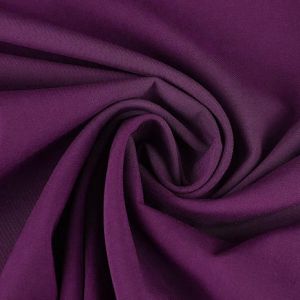
Applications of Digital Textile Printing
Digital textile printing is used in four main areas: apparel and clothing, interior decoration, banners and signage, and industrial applications. As of 2021, apparel and clothing accounted for the largest share of digital textile printing, with 53% of the market. The dynamic nature of the fashion industry and the high demand for fast, on-demand order fulfillment have significantly increased the popularity of digital printing in this sector. Experts predict that between 2022 and 2030, digital apparel printing will grow at an annual rate of 12.5%. The ability to print a wide variety of designs with any level of detail has made digital printing highly desirable in the fashion and clothing industry.
Interior decoration is considered the second fastest-growing area of digital textile printing, continuing to rise with an annual growth rate of 12.3%. Digital printing is also widely used for producing banners, flags, and signage for both indoor and outdoor exhibitions, making it another key application of this technology.
Types of Inks in Digital Textile Printing
The high demand for dye-sublimation printing has led this type of ink to capture over 52% of the market share by 2021. Dye-sublimation inks are more durable compared to other types because, unlike other inks that sit on the surface of the fabric and form a layer, these inks penetrate into the fabric fibers. Dye-sublimation inks are widely used for printing on polyester fabrics. Forecasts suggest that the popularity of these inks will grow at an annual rate of 12.5% through 2030. They are also more sustainable than other inks, as there is no need to wash the fabric after printing, unlike many other ink types.
Reactive inks are the second most common category used in textile printing, primarily applied to cotton and silk fabrics. The projected annual growth rate for reactive inks during the forecast period is 12.2%.
Acid inks are used for printing on fabrics that do not readily absorb color, such as wool and silk. Pigment inks are the least commonly used among digital textile inks and are applied infrequently.
Inkjet Technology in Digital Textile Printing
Sun Chemical, a company active in the field of textile printing materials, recently announced its decision to adopt Sensient Imaging’s technology for textile printing—a move that appears to be highly suitable for the industry. Sun Chemical is considered one of the largest companies in the digital textile printing sector and extensively uses inkjet technology as its primary printing method. However, by leveraging Sensient Imaging’s technology—one of the top fifteen ink manufacturers in North America—the company is expected to significantly expand its capabilities and areas of operation.
Currently, digital textile printing technologies account for only 6% of the market share, which remains relatively small. Nevertheless, the growth potential in this field is substantial. With the advancement of specialized machinery and inks for digital textile printing, opportunities for growth continue to expand.
One of the current concerns in the textile printing industry is keeping pace with the rapidly changing fashion industry. To align with the dynamic and variable demands of fashion orders, the textile printing sector must adopt digital technologies that not only accelerate the printing process but also allow for quick and easy customization of designs.

The Textile Industry’s Shift Toward Digital Printing
The textile industry is rapidly adapting to digital printing technologies. The growth of digital printing in this sector is inevitable, as changing customer behavior is pushing textile manufacturers to take advantage of the many benefits digital printing has to offer.
Seasonal fashion trends, the need for a wide variety of colors and designs in line with the latest styles, and the constant release of new clothing collections by leading global brands all make it clear that traditional textile printing methods can no longer meet today’s consumer demands. Without digital printing, the industry simply cannot keep up.
Moreover, as sustainability becomes an increasingly important issue in both production processes and the final product, digital printing stands out as the most environmentally friendly technology. It produces less waste and consumes significantly less water and energy compared to conventional methods.
Another major advantage of digital printing over traditional pro
cesses like screen printing or flatbed printing is flexibility. There’s no longer a need for large minimum order quantities—no requirement for 1,000 units per run to justify the cost. With digital printing, even small batch orders—as few as a handful of items—can be processed efficiently.
Printing complex designs with multiple colors is no longer a risky or difficult task; it’s an area where digital printing truly excels. In summary, the demand for fast turnaround times, the ability to quickly adapt to changing orders, sustainable production, and high-quality results all strongly underline the necessity of adopting digital technologies in the textile industry.
Designers and Digital Printing
One of the most important factors driving the growth of digital printing in the fashion industry is fashion designers. The use of inkjet machines instead of traditional printers like flatbed or screen printers allows designers to produce their designs in any quantity they desire, in less time, and make quick modifications whenever necessary.
From a designer’s perspective, digital printing means fewer limitations and access to an endless range of colors. With rotary printing, designers are limited to just 8 to 12 colors, and preparing each screen cylinder can cost up to $3,000. Digital printing eliminates these constraints, enabling designers to freely express their creativity.
With digital printing, designers no longer need to produce large quantities to make printing cost-effective. Instead, they can print in very limited quantities based on current needs, and revise or update the design later. This flexibility helps avoid overproduction and excess inventory that may not be used.
There are many reasons to choose digital textile printing over more traditional methods: freedom to print any quantity, the ability to reproduce intricate and delicate designs, and the significant reduction in chemical waste and water consumption—both of which are critical for environmental sustainability.
Greater flexibility and the ability to quickly implement creative ideas onto the final product are among the most valued benefits for designers, and digital printing makes this possible. In fact, digital textile printing provides an ideal solution to the challenges and limitations faced by designers working in the fashion and apparel industry.
Today, between 20% and 30% of fabric printing in fashion is done using digital processes. With customer preferences increasingly leaning toward personalized and customized clothing, this figure is expected to grow rapidly in the coming years.
Digital Textile Printing by Region
Asian countries are expected to experience the highest growth in the digital textile printing market, with an annual growth rate of 15.1%, largely due to the presence of major textile printing manufacturers in the region. China and India are projected to hold the largest market shares in this industry. As one of the world’s leading exporters of textiles and garments, China is expected to remain a dominant force in digital textile printing through 2030.Other countries such as Bangladesh, Vietnam, and Japan are also expected to see rapid growth in digital textile printing during the forecast period.
Digital Textile Printing by Region
Asian countries are expected to see the highest growth in the digital textile printing market, with an annual growth rate of 15.1%, due to the presence of major textile printing manufacturers. China and India will dominate the market. China, being one of the largest exporters of textiles and garments globally, is projected to be one of the leading countries in digital textile printing by 2030. Bangladesh, Vietnam, and Japan are also expected to grow rapidly in this field during the forecast period.




